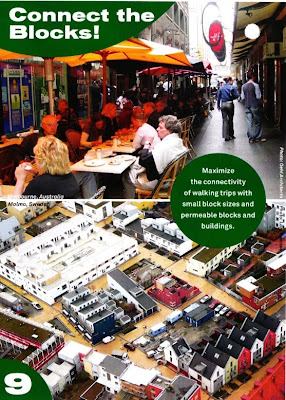 A nifty exhibition,Our Cities Ourselves, is on view until September 11, 2010 at the Center for Architecture in Greenwich Village (Mon-Fri: 9am to 8pm; Sat: 11am to 5pm).
A nifty exhibition,Our Cities Ourselves, is on view until September 11, 2010 at the Center for Architecture in Greenwich Village (Mon-Fri: 9am to 8pm; Sat: 11am to 5pm).It shows ten architects' treatment of potential changes in ten world cities--nearly all in developing nations.
Accompanying the exhibition is a publication titled "Our Cities Ourselves: 10 Principles for Transport in Urban Life," written by internationally famous Danish urbanist Jan Gehl and Walter Hook, Executive Director of the Institute of Transportation and Development Policy (ITDP).
"Cities of the twenty-first century should be lively cities, safe cities, sustainable cities and healthy cities," said Gehl in a news release. "All of these qualities can be achieved if we embrace these ten principles, which means putting people first."
The principles and Atlantic Yards
Notably, two of the ten principles of sustainable transport don't quite work when it comes to Atlantic Yards.
The project would not have "small-size, permeable buildings and blocks" that enhance pedestrian life, as suggested above. In fact, it would create two superblocks.
 And while the project would involve density around transit, as suggested at right, that won't necessarily make it a desirable urban district, given the level of density intended, the parking included, and the attendant traffic.
And while the project would involve density around transit, as suggested at right, that won't necessarily make it a desirable urban district, given the level of density intended, the parking included, and the attendant traffic.The principles
1. Walk the walk: Create great pedestrian environments.
2. Powered by people: Create a great environment for bicycles and other non-motorized vehicles.
3. Get on the bus: Provide great, cost-effective public transport.
4. Cruise control: Provide access for clean passenger vehicles at safe speeds and in significantly reduced numbers.
5. Deliver the goods: Service the city in the cleanest and safest manner.
6. Mix it up: Mix people and activities, buildings and spaces.
7. Fill it in: Build dense, people and transit oriented urban districts that are desirable.
8. Get real: Preserve and enhance the local, natural, cultural, social and historical assets.
9. Connect the blocks: Make walking trips more direct, interesting and productive with small-size, permeable buildings and blocks.
10. Make it last: Build for the long term. Sustainable cities bridge generations. They are memorable, malleable, built from quality materials, and well maintained.
 The proposal for New York
The proposal for New YorkFrom the Project Architect: Terreform and Michael Sorkin Studio:
New York has continually been characterized by transformation and rapid change and become a template for American society and cities around the world. The impact of New York’s physical structure and the density of its population becomes most evident when assessing its transport system and mobility patterns.The cities and the architects
Site
Manhattan side of the Brooklyn Bridge, a no-man’s land of spaghetti highways and parking lots. The elevated southbound FDR Drive dominates, despite carrying minimal traffic south of the bridges, even in rush hour. Originally restricted to mass transit, the Bridge is now open only to private cars. Some 4,000 pedestrians and more than 2.600 cyclists cross it every day.
Proposal
Create two-way lanes for cyclists on the lower level of the Bridge and free up the elevated walkway for pedestrians only. Remove FDR Drive from the south side of Manhattan Bridge and create a green public space with shops and cafes at the anchorage to Brooklyn Bridge. Make Lower Manhattan an ‘eco-zone’, with vehicle access fees and restrictions to only ultra-clean cars and trucks. Freight is delivered by barge to a new transfer terminal.
- Ahmedabad, India/HCP Design and Project Management
- Budapest, Hungary/Varos-Teampannon and Kozlekedes
- Buenos Aires, Argentina/PALO Arquitectura Urbana
- Dar es Salaam, Tanzania/Adjaye Associates
- Guangzhou, China/Urbanus Architecture & Design
- Jakarta, Indonesia/Budi Pradono Architects
- Johannesburg, South Africa/Osmond Lange Architects, Ikemeleng Architects
- Mexico City, Mexico/arquitectura 911sc
- New York, NY, USA/Terreform and Michael Sorkin Studio
- Rio De Janeiro, Brazil/Fábrica Arquitetura and CAMPO aud
I think Atlantic Yards doesn't meet principle #8:
ReplyDelete"8. Get real: Preserve and enhance the local, natural, cultural, social and historical assets."